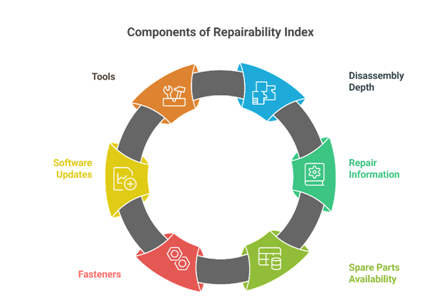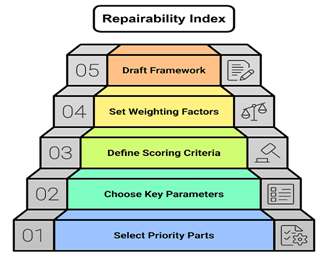Committee’s recommendations in alignment with best global practices facilitating industry with innovation and ease of doing businessRepairability Index enabling framework applies to
Smartphones and Tablets
Smartphones and Tablets
The Committee constituted for the Framework on Repairability Index (RI) in Mobile and Electronic Sector has submitted its Report to Smt. Nidhi Khare, Secretary, Department of Consumer Affairs, Government of India.
The committee’s recommendations have been framed in alignment with the best global practices without causing any impediment to the industry with regard to innovation and ease of doing business. The Original Equipment Manufacturers (OEMs) are required to self-declare the Repairability Index based on a standards scoring criteria provided in the framework with no additional compliance burden.
Further, the committee recommended that the Repairability Index should be displayed at the point of sale/purchase, E-commerce platforms and in form of QR code on packaged products to enable consumer to make informed choices.
Repairability Index aims to create an ecosystem , where consumers choose options that align with the ethos of ‘mindful utilization’ of their products over ‘wasteful consumption’. By empowering consumers with ease and hassle-free repair options, the Department of Consumer Affairs is reaffirming its commitment to a self-reliant, sustainable, and consumer-friendly economy.
Pertinently, an analysis of grievances received at National Consumer Helpline (NCH) indicates that large number of consumers witness issues while seeking repair for their mobile phone and tablets. There has been significant rise in complaints in Mobiles and Tablets product category from 19,057 in 2022-2023 followed by 21,020 in 2023-2024 and further to 22,864 in 2024-2025, which also highlighted a pressing need to improve repair accessibility and ensure greater transparency of repair and post-sale service-related information to consumers.
In September 2024, the Department of Consumer Affairs (DoCA), constituted a committee under the chairmanship of Shri Bharat Khera, Additional Secretary for developing the framework of the Repairability Index (RI).
The committee included
- Stakeholders from the industry with companies like Apple., Samsung, Google, Vivo, HMD Mobiles., Dell, HP.
- Prominent Industry associations like ICEA and MAIT,
- Representatives from consumer organisations like EPIC,
- Members of academia and senior officials of DoCA, Meity, MSME
- Scientific organisations such as NTH and BIS
The committee was mandated to recommend a robust framework for Repairability Index (RI) in Mobile and Electronics Sector. Based on the deliberations, the committee has identified smartphones and tablets as a product category for notification in the initial phase of Repairability Index in Mobile and Electronics Sector.
The committee identified priority parts which are most prone to frequent failures and have high functional relevance as below:
- Battery,
- Display assembly,
- Back cover assembly,
- Front-facing camera assembly,
- Rear-facing camera assembly,
- Charging port,
- Mechanical buttons,
- Main microphone(s),
- Speaker,
- Hinge assembly or mechanical display folding mechanism,
- External audio connector(s).
Several meetings of the Committee were conducted to deliberate and discuss for identifying parameters for Repairability Index. Repairability is assessed on six core parameters, namely
- Disassembly Depth,
- Repair Information,
- availability of Spare Parts within a reasonable timeline,
- Software Updates,
- Tools and
- Fasteners (types and availability).

Scoring criteria was evolved for each of these parameters and weightages were decided. After aggregation of weightages for priority parts, a RI on a five-point numeric scale is arrived at.
The Committee actively engaged with a wide array of relevant stakeholders, including manufacturers, industry associations, consumer advocacy groups, and representatives of government. These consultations were vital for gathering diverse perspectives and ensuring the proposed framework is practical, effective, and addresses the needs and challenges faced by the consumers in India to utilize their product as long as they want.
As India continues its rapid technological advancement and more and more consumers have access to a variety of consumer products, the need for robust after sales support and equitable repair practices is becoming increasingly crucial. For countless consumers, both in rural and urban areas, access to affordable repair options is fundamental.
In view of this growing demand for a robust repair ecosystem, the Department of Consumer Affairs (DoCA) had launched the Right to Repair Portal India in 2022, to facilitate relevant repair associated information between the companies and consumers in 4 (four) sectors namely, Automobile, Mobile and Electronics, Consumer Durables and Farming Equipment.
Over the last two years, consistent efforts have been made by the Department to use this portal for dissemination of repair related information. More than 65 companies across above four sectors have on boarded the portal and offer relevant repair related information to consumers.
Over the past few years, the rapid growth of the smartphone and tablet market in India has significantly transformed the digital landscape, with smartphones and tablets becoming integral to daily life for millions of people. A National Workshop was conducted in August 2024 wherein it was unanimously agreed that a Repairability Index framework in Mobile and Electronics sector will help consumers assess the ease of repairability of smartphones and tablets and enable them to make an informed choice amongst products available in market based on their repairability.
****
Abhishek Dayal/Nihi Sharma





